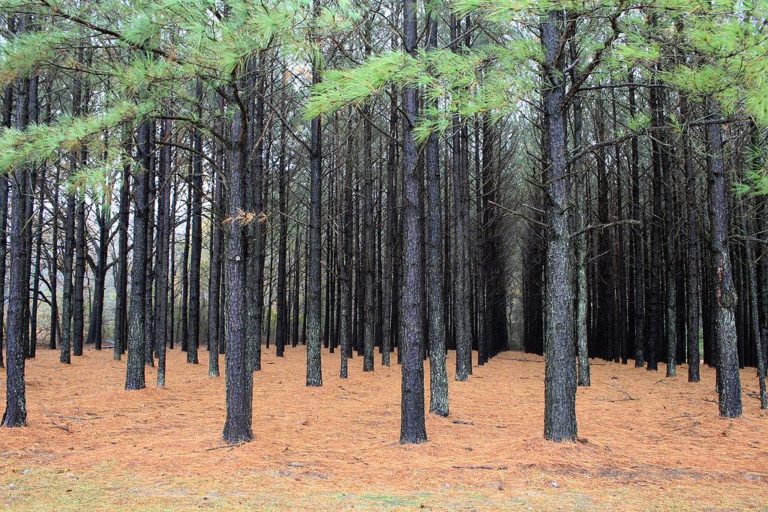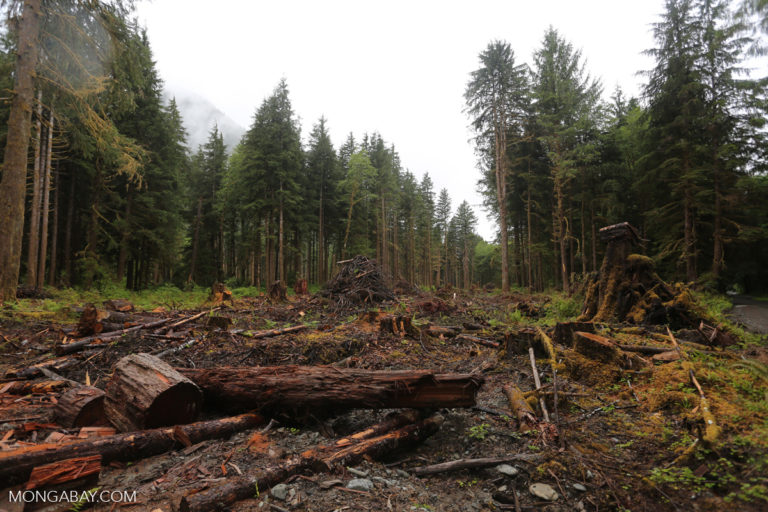- Despite how critical forest protection is to meeting climate goals, it is not currently seen as a climate priority in the U.S.
- In fact, the report notes, some government and forestry industry actors even promote increased logging as a solution to climate change, which has led to the forests of the coastal Southern United States becoming the largest source of wood pellet exports to Europe in recent years.
- Forest disturbance from logging in the Southern U.S. occurs at four times the rate that it does in the rainforests of South America, the authors of the report discovered, which is reducing the ability of the country’s forests to act as carbon sinks by at least 35 percent.
A report released today, on the International Day of Forests, finds that forest protection in the United States must be drastically increased in order to mitigate the climate crisis and safeguard communities from the extreme weather events climate change is projected to continue to make more frequent and more severe.
Despite how critical forest protection is to meeting these goals, it is not currently seen as a climate priority in the U.S.
In fact, the report notes, some government and forestry industry actors even promote increased logging as a solution to climate change, which has led to the forests of the coastal Southern United States becoming the largest source of wood pellet exports to Europe in recent years. The pellets are burned in power stations to generate electricity and accounted for as a carbon-neutral fuel source, though there is considerable debate about whether or not the burning of biomass for energy can be considered “zero carbon.”
“We cannot log and burn our way out of climate change,” Dr. Bill Moomaw, a report author and Professor of International Environmental Policy at Tufts University, said in a statement. “Logging forests and burning trees to generate electricity in place of coal while not counting the emissions may help governments meet their emission goals, but the atmosphere and climate is where the real accounting takes place.”
Despite the fact that forests have been helping to regulate the global carbon cycle for 300 million years, Moomaw added, “their potential to address climate change in the coming centuries is significantly underestimated.” Moomaw was a coordinating lead author of a 2001 Intergovernmental Panel on Climate Change (IPCC) report on greenhouse gas emissions reduction, as well as lead author of three other IPCC reports. The IPCC’s work was awarded with a Nobel Peace Prize in 2007.

The U.S. is the largest producer and consumer of wood products in the world. U.S. forests are responsible for providing close to 30 percent of the world’s wood pulp and nearly 20 percent of roundwood, more than any other country. Moomaw and report co-author Danna Smith, executive director of the North Carolina-based NGO Dogwood Alliance, found that 85 percent of carbon loss from U.S. forests between 2006 and 2010 was driven by logging activities — five times the combined forest-related emissions from conversion, droughts, fires, insects, tree mortality, and wind.
Cutting forests down to burn them for energy is something of a double-jeopardy scenario for the climate: the harvesting and burning of wood-based biomass directly causes emissions, while forests’ capacity as a carbon sink is also diminished, as there are less trees removing carbon from the atmosphere and the carbon storage potential of soil is also compromised.
Forest disturbance from logging in the Southern U.S. occurs at four times the rate that it does in the rainforests of South America, Moomaw and Smith discovered, which is reducing the ability of the country’s forests to act as carbon sinks by at least 35 percent — a figure that would be even higher if soil carbon emissions due to logging were included, which would likely flip forests from constituting a carbon sink to a carbon source. In a report released last year, the Environmental Protection Agency (EPA) estimated that forests removed approximately 11.5 percent of total U.S. emissions in 2014 — which Moomaw and Smith note is less than half of the 25 percent global average.
Tens of millions of acres of the U.S.’s natural forests have been replaced by monocrop timber plantations, according to the report. Diverse old-growth forests are superior carbon sinks, but today less than 15 percent of U.S. forests are over 100 years old. While forest acreage in the U.S. has remained relatively stable over the past century, the extent of forests is only 70 percent of what it once was — and that figure drops to 62 percent if you don’t count tree plantations.
“As a result, U.S. forests are no longer the vast, complex, highly functioning climate-regulating systems they once were, having lost significant climate stabilization capacity,” per the report. “In fact, in the United States, 60 percent of the carbon lost through deforestation and harvesting from 1700 to 1935 has not yet been recovered.”
While the United States’ commitment to the Paris Climate Agreement is in doubt under the new Trump Administration, the U.S. has not yet begun to formally withdraw, and some administration officials — such as Secretary of State Rex Tillerson, the former Exxon CEO — have even suggested that the U.S. should remain in the pact. If the country intends to honor the commitments made in the agreement, Moomaw said, it’s going to need to “aggressively reduce emissions from fossil fuels while also accelerating the removal of atmospheric carbon dioxide by protecting and restoring forests here at home.”
The U.S. could reduce annual emissions by 75 percent over the next fifty years if it were to halt deforestation, protect its remaining forests, and restore degraded forests. And if fossil fuels were rapidly phased out at the same time, it is possible to reduce the amount of carbon in the atmosphere enough to meet the goals of the Paris Agreement and avoid catastrophic climate change, the researchers state in the report.
“Standing forests are the only proven system that can remove and store vast amounts of carbon dioxide from the atmosphere at the scale necessary to keep global temperature rise below 1.5 degrees Celsius this century,” Moomaw and Smith write. “It is therefore essential to not only prevent further emissions from fossil fuels, deforestation, forest degradation, and bioenergy, but also to expand our forests’ capacity to remove carbon from the atmosphere and store it long-term.”
It’s not just a climate issue, either: The degradation of forests caused by logging activities compromises critical ecological services other than carbon storage that are performed by forests, including water purification, flood control, and the provision of habitat for wildlife. Many of these services are critical in helping to buffer vulnerable communities against natural disasters, which not only pose a threat to the health and wellbeing of residents but cost billions of dollars annually. “These are threats that could be mitigated and costs that could be reduced by expanding protection for forests along rivers,” the authors write.
Moomaw and Smith suggest in the report that government incentives for bioenergy and other forest products like wood, pulp, and paper should be repurposed as payments for the ecosystem services provided by standing forests. This would help provide incentives for transforming the forestry sector such that U.S. consumption of wood products no longer exceeds the ecological limits of forests.
Smith said that she and Moomaw hope that the new report will spur leaders across federal, state, and local governments, as well as businesses, nonprofits, and citizens, to “accelerate actions to protect and restore our nation’s forests to help solve the climate crisis and protect our most vulnerable communities from the worst effects of climate change.”

FEEDBACK: Use this form to send a message to the author of this post. If you want to post a public comment, you can do that at the bottom of the page.